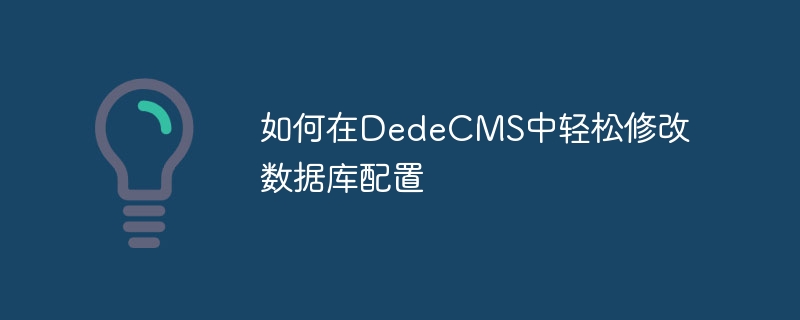Home >Backend Development >PHP Tutorial >How to easily modify database configuration in DedeCMS
How to easily modify database configuration in DedeCMS
- WBOYWBOYWBOYWBOYWBOYWBOYWBOYWBOYWBOYWBOYWBOYWBOYWBOriginal
- 2024-03-14 18:51:03715browse

Title: How to easily modify the database configuration in DedeCMS, specific code examples are required
Database configuration is a very important part of the website construction process, it directly affects the website The operating effect and performance of the system. For developers who use DedeCMS to build websites, it is very necessary to be proficient in how to easily modify the database configuration in DedeCMS. In this article, we will introduce in detail how to modify the database configuration in DedeCMS and give specific code examples. We hope that the guidance in this article can help readers better understand and apply database configuration.
Step one: Log in to the DedeCMS backend management system
First, we need to open the browser, enter the domain name of the website in the address bar, then add "/dede" after the domain name, and return Car enters the backend management system of DedeCMS. Enter the correct user name and password on the login page. After successful login, we can start modifying the database configuration.
Step 2: Enter the database configuration page
In the DedeCMS background management system, we need to click the "System" option in the left menu, and then select "Basic System Parameters" to configure. In the system basic parameters page, you can see the "Database Connection" column. Click the "Database Configuration" button under this column to enter the database configuration page.
Step 3: Modify the database configuration information
In the database configuration page, we can see various database configuration information options, including database type, database address, database port, and database name. , database user name, database password, etc. According to the actual situation, modify these database configuration information to ensure that it is consistent with the information in the server database. Specifically, we need to find the following code example on the page:
$cfg_dbtype = 'mysql'; // 数据库类型 $cfg_dbhost = 'localhost'; // 数据库地址 $cfg_dbname = 'dedecms'; // 数据库名称 $cfg_dbuser = 'root'; // 数据库用户名 $cfg_dbpwd = 'password'; // 数据库密码 $cfg_dbprefix = 'dede_'; // 表名前缀
Modify the database type, database address, database name, database user name, database password and other information in the above code according to the actual situation to ensure the accuracy of the information sex and integrity. After the modification is completed, click the "Save Changes" button at the bottom of the page to complete the modification of the database configuration.
Step 4: Check whether the database configuration is effective
After modifying the database configuration information, we need to find the "Database Test" button on the page. Click this button to test the database configuration information. Ensure the accuracy and validity of connection configurations. If a successful connection message appears, it means that the database configuration has taken effect; otherwise, you need to check the accuracy of the configuration information, re-modify the configuration information and test.
Through the above steps, we can easily modify the database configuration in DedeCMS and configure it using specific code examples. The correctness and stability of the database configuration are crucial to the normal operation of the website system. It is recommended that developers operate with caution when modifying the configuration to ensure the accuracy and validity of the information. I hope the content of this article will be helpful to readers and help them better apply and understand database configuration.
(Note: The above code examples are for reference only, and the specific configuration information needs to be modified according to the actual situation.)
The above is the detailed content of How to easily modify database configuration in DedeCMS. For more information, please follow other related articles on the PHP Chinese website!

